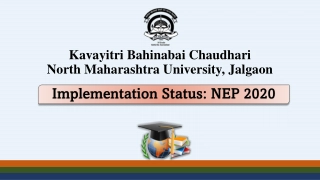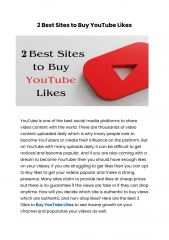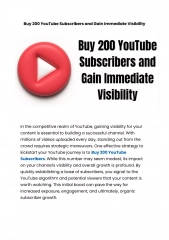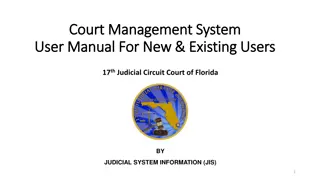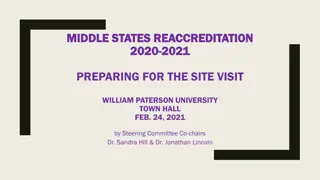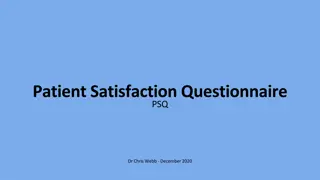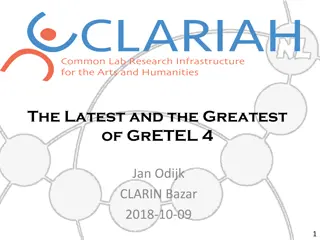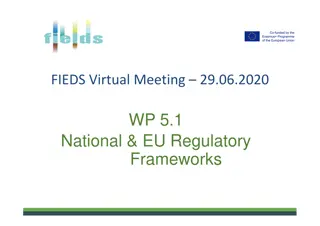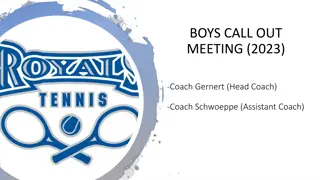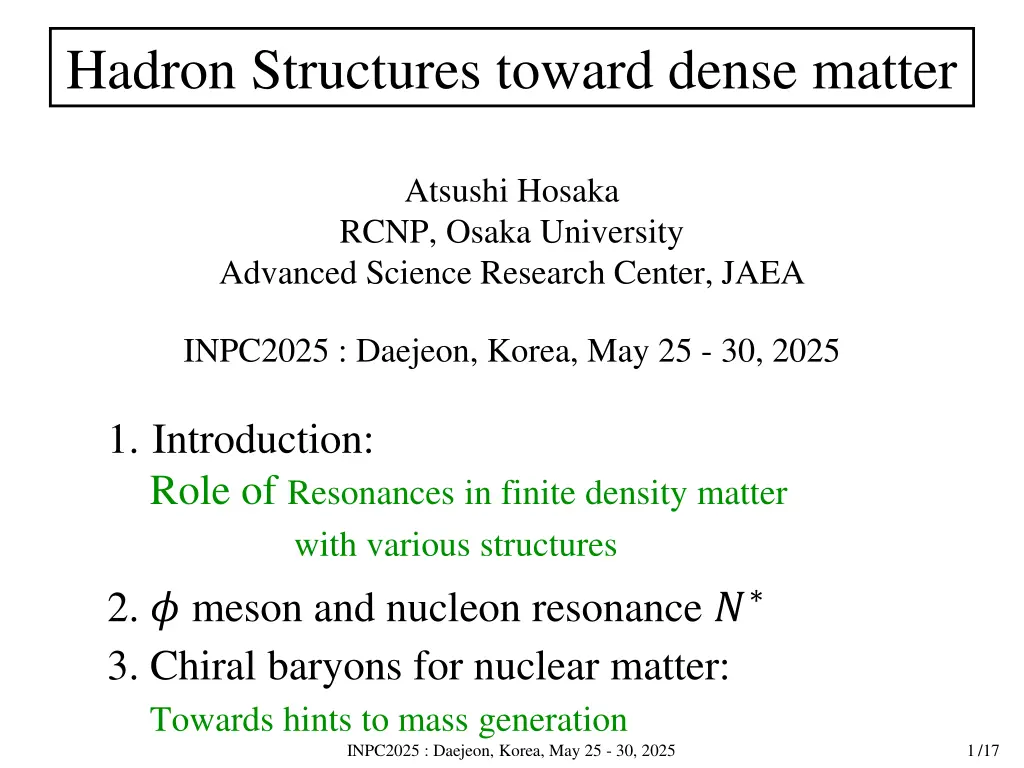
Understanding Hadron Structures and Resonances in Dense Matter
Explore the role of resonances in finite density matter with various structures, focusing on chiral baryons and their implications for mass generation. Delve into the mixing of compact and extended structures in hadron formation, with a special emphasis on meson and nucleon resonances. Discover the potential links between quarks and Yukawa couplings in nuclear matter, along with the significance of meson-dressed N* resonance in dense environments.
Uploaded on | 1 Views
Download Presentation

Please find below an Image/Link to download the presentation.
The content on the website is provided AS IS for your information and personal use only. It may not be sold, licensed, or shared on other websites without obtaining consent from the author. If you encounter any issues during the download, it is possible that the publisher has removed the file from their server.
You are allowed to download the files provided on this website for personal or commercial use, subject to the condition that they are used lawfully. All files are the property of their respective owners.
The content on the website is provided AS IS for your information and personal use only. It may not be sold, licensed, or shared on other websites without obtaining consent from the author.
E N D
Presentation Transcript
Hadron Structures toward dense matter Atsushi Hosaka RCNP, Osaka University Advanced Science Research Center, JAEA INPC2025 : Daejeon, Korea, May 25 - 30, 2025 1. Introduction: Role of Resonances in finite density matter with various structures 2. ? meson and nucleon resonance ? 3. Chiral baryons for nuclear matter: Towards hints to mass generation INPC2025 : Daejeon, Korea, May 25 - 30, 2025 /17 1
1. Introduction Hadrons Hadron matter Quark matter Energy Color super state Two-body force Three-body force Diquarks ? Density Spectroscopy Structures and interactions Equation of states Hadrons are Basis for Finite/High density matter INPC2025 : Daejeon, Korea, May 25 - 30, 2025 /17 2
Various structures Ground states INPC2025 : Daejeon, Korea, May 25 - 30, 2025 /17 3
Various structures Ground states Resonances Orbitally excited Pair created Compact quarks e.g., diquark + triquark Extended molecules e.g., meson + baryon INPC2025 : Daejeon, Korea, May 25 - 30, 2025 /17 4
For hadron structure Mixing of Compact and Extended structure is interesting X(3872), ??, (2012), For X M. Takizawa and S. Takeuchi, Prog. Theor. Exp. Phys. 2013, 093D01 Y. Yamaguchi, AH, S. Takeuchi and M. Takizawa, J.Phys.G 47 (2020) 5, 053001 . For Pc Giachino, Yamaguchi, AH, Santopinto, Takeuchi, Takizawa, Yamaguchi, Phys.Rev.D 108 (2023) 7, 074012, Phys.Rev.D 101 (2020) 9, 091502, Phys.Rev.D 96 (2017) 11, 114031 . For (2012) QF. Lyu, H. Nagahiro, AH, hys.Rev.D 107 (2023) 1, 014025, N. Su, HX. Chen, P. Gubler, AH, hys.Rev.D 110 (2024) 3, 034007 But today, ? and related nucleon resonance ? as molecules INPC2025 : Daejeon, Korea, May 25 - 30, 2025 /17 5
2. ? meson and nucleon resonance ? ?(1020),???= 1 ,almost?? Narrow width 4.2 MeV, suited to a small mass shift Would be relevant for dense matter (with (anti)strangeness) At first sight: ?? does not play for nuclear matter (~ u, d quarks) But large link between u, d and s quarks Yukawa coupling, ??? 3 ~ ???? 5/3 WT couplings ? ? ??? ?? ??? ? ? ? ??? ?? N* resonance around 2 GeV may be dressed by mesons with s-quark mB molecules INPC2025 : Daejeon, Korea, May 25 - 30, 2025 /17 6
Coupled channel model with PS and V mesons Khemchandani, Kaneko, Nagahiro, AH, Phys.Rev.D 83 (2011) 114041 Khemchandani, Martinez, Kaneko, Nagahiro, AH, Phys.Rev.D 84 (2011) 094018 Khemchandani, Martinez, Nagahiro, AH, Phys.Rev.D 85 (2012) 114020, Phys.Rev.D 88 (2013) 11, 114016, Phys.Rev.D 103 (2021) 1, 016015 Abreu, Gubler, Khemchandani, Martinez, AH, Phys.Lett.B 860 (2025) 139175 Contains s, t, u, and c terms ?? ?? 4 PS and 5 V channels ? PS:??,??,? ,? V:??,??,??,? ,? , ?? ?? Interactions are dictated by low energy theorems of chiral symmetry Amplitudes are obtained by LS equation ? = 1 ??= ? + ??? + ????? + ? INPC2025 : Daejeon, Korea, May 25 - 30, 2025 /17 7
Some details t c u s INPC2025 : Daejeon, Korea, May 25 - 30, 2025 /17 8
Amplitudes show strong attraction for ?? channels Spin = 3/2 Spin = 1/2 (Spin averaged) correlation agrees well with data ALIS, S. Acharya, et al., Phys. Rev.Lett. 127 (17) (2021) 172301 INPC2025 : Daejeon, Korea, May 25 - 30, 2025 /17 9
3. Chiral baryons for nuclear matter We can trace back to 1970 th, S. Weinberg INPC2025 : Daejeon, Korea, May 25 - 30, 2025 /17 10
3. Chiral baryons for nuclear matter We can trace back to 1970 th, S. Weinberg Hadrons classified by chiral multiplets INPC2025 : Daejeon, Korea, May 25 - 30, 2025 /17 11
Strategy Chiral symmetry is spontaneously broken, but not very badly. Baryons are classified by chiral multiplets. Broken symmetry is taken care of by their mixing. Models of chiral baryons B. W. Lee, Chiral Dynamics (Gordon and Breach, New York, 1972) C. DeTar and T. Kunihiro, Phys. Rev. D 39 (1989), 2805 D. Jido, M. Oka and A. Hosaka, Prog. Theor. Phys. 106 (2001), 873 For ? and ? of mirror baryons Two mass generation mechanisms; ?0 ?2 and ?? ?? unknown known INPC2025 : Daejeon, Korea, May 25 - 30, 2025 /17 12
Chiral multiplets/representations Various structures encoded in (higher) dimension ??(2)? ??(2)? (??,??) ~ dimension of ??(2)?,?; isospin group for u, d quarks Elementary spin 1/2 fermion: left (l) and right (r) helicity components ? = ??+ ?? 2 corresponds to isospin , = (2,0) + (0,2) This applies to the elementary quarks Composite spin 1/2 fermion qqq baryons: [(2,0) + (0,2)]3 [(2,0) + (0,2)] + [(3,2) + (2,3)] + [(4,1) + (1,4)] ? INPC2025 : Daejeon, Korea, May 25 - 30, 2025 /17 13
Resonances ~ Composite spin 1/2 fermion Multiquarks; ????? or ???+ meson clouds ~ 5 quarks 5 [(2,0) + (0,2)] ????? [(2,0) + (0,2)]3+ (1/2,1/2) ??? + meson [(2,0) + (0,2)] + [(0,2) + (2,0)] + [(3,2),(2,3)] + [(2,3),(3,3)] + Mirror ? ? Mirror With meson cloud, or multi quark components, higher dimensional multiplets are possible => Chiral baryon models. INPC2025 : Daejeon, Korea, May 25 - 30, 2025 /17 14
Application to neutron stars for ?0 Motohiro, Kim, Harada, PRC92, 025201 (2015) Minamikawa, Kojo, Harada, PRC103, 045205 (2021) Gao, Yuan, Harada, Ma, PRC110, 045802 (2024) Hybrid model of chiral mesons, baryons and NJL type quarks ?,? ,?,?,?,? ?,?(diquark) Quarks Hadrons ?0 + INPC2025 : Daejeon, Korea, May 25 - 30, 2025 /17 15
MR plot INPC2025 : Daejeon, Korea, May 25 - 30, 2025 /17 16
Summary Hadrons (resonances) show various structures Quark (compact) originated Hadron (extended) originated ~ would affect more matter properties Resonances are relevant for dense matter ~ origin of many-body force . ? meson couples to nucleon resonance around 2 GeV Chiral symmetry restoration can be studied by chiral multiplets Higher dimensional multiplets ~ resonances with multi quarks Chiral baryon scheme Another mass generation mechanism ?0 Neutron stars may shed light on elementary questions of QCD INPC2025 : Daejeon, Korea, May 25 - 30, 2025 /17 17

